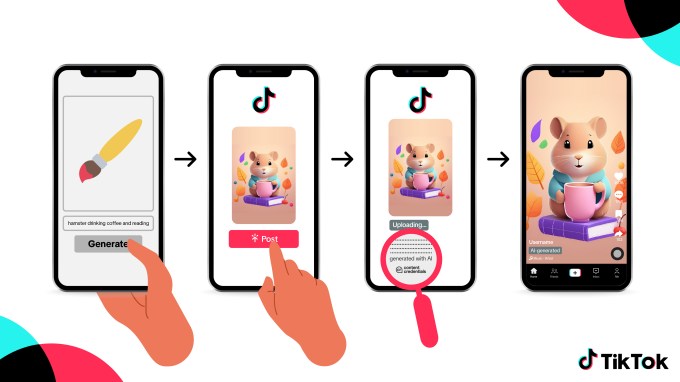TikTok is beginning to robotically label AI-generated content material created on different platforms, the corporate stated Thursday. With this modification, if a creator posts content material on TikTok that was created utilizing a service like OpenAI’s DALL·E 3, it would robotically have an “AI created” label connected to it to inform viewers that it was created utilizing AI.
The social video platform does this by implementing Content material Credentials, a expertise from the Coalition for Content material Origin and Authenticity (C2PA), co-founded by Microsoft and Adobe. Content material credentials connect particular metadata to content material, which TikTok can then use to immediately acknowledge and label AI-generated content material.
In consequence, TikTok will start robotically labeling AI-generated content material that’s uploaded to the platform with content material credentials connected. The change will go into impact on Thursday and can apply to all customers worldwide within the coming weeks.
Bye TikTok already labels content material which was created utilizing TikTok AI results, it would now label content material created on different platforms that implement content material credentials, equivalent to OpenAI’s DALL·E 3 and Microsoft’s Bing Picture Creator. Though Microsoft, Adobe and OpenAI already help Content material Credentials, Google promised to help content material credentials.

Whereas TikTok already requires creators to reveal once they publish content material created or enhanced by AI, the corporate informed TechCrunch it sees the brand new change as an extra approach to make sure AI-generated content material is labeled and likewise takes the stress on the creators.
Within the coming months, TikTok will even start attaching content material credentials to AI-generated content material created on the platform utilizing TikTok AI results. Content material credential metadata will embody particulars about the place and the way AI-generated content material was created or edited, and can stay connected to the content material when uploaded. Different platforms that use content material credentials will have the ability to robotically flag content material as created by synthetic intelligence.
So whereas TikTok has dedicated to labeling AI content material by itself service, it’s also dedicated to serving to be sure that AI content material created on TikTok can be precisely labeled when printed on one other platform.
“There’s unimaginable creativity in AI-generated content material, however transparency for viewers is essential,” Adam Presser, head of operations, belief and security at TikTok, stated in a press launch. “By collaborating with colleagues to label content material throughout platforms, we’re making it simpler for creators to responsibly discover AI-generated content material whereas persevering with to curb dangerous or deceptive AIGCs which might be prohibited on TikTok.”
TikTok touts that it’s the first video-sharing platform to implement content material credentials. It is value mentioning that Meta introduced again in February, the corporate plans to make use of a C2PA answer so as to add provenance to content material.
As a part of Thursday’s announcement, TikTok stated it’s dedicated to combating the usage of deceptive synthetic intelligence in elections and that its insurance policies strictly prohibit deceptive content material generated by synthetic intelligence, whether or not labeled or not.
